In this post we will review available methods you can use to reset Windows 11 with Remove everything or Keep my files options.
You can use this option when you need to improve the performance of your PC when it is not running well due to recently installed apps, drivers, or updates. This process involves reinstalling the operating system, allowing you to choose whether to keep your personal files or remove them before proceeding with the reinstallation.
Advertisеment
Before we start, let's learn the basics on what each of the reset types does.
Available Windows Reset Types
Keep my files > Change settings > Preinstalled apps On
- Reinstalls Windows 11.
- Retains all user accounts and personal files located in C:\Users.
- Removes any apps and drivers that were installed by the user.
- Undoes any changes made to settings.
- Reinstates any apps originally installed by your PC manufacturer if Windows 11 was preloaded on your computer.
Keep my files > Change settings > Preinstalled apps Off
- Reinstalls Windows 11.
- Preserves all user accounts and personal files located in C:\Users.
- Removes any user-installed apps and drivers.
- Reverts any changes made to settings.
- Removes any preinstalled apps from your PC manufacturer if Windows 11 was preloaded on your computer.
Remove everything
- Reinstalls Windows 11.
- Erases all user accounts and personal files.
- Removes all user-installed apps and drivers.
- Reverts any changes made to settings.
- Removes any preinstalled apps from your PC manufacturer. (Note: If your PC came with Windows 10, apps from your manufacturer will be reinstalled.)
ℹ️ Note: When selecting "Remove everything" > "Change settings", you have two options for data erasure.
- Data erasure set to On securely deletes files and cleans the drive, ideal for preparing your PC for donation, recycling, or sale. This process may take a couple of hours but helps prevent others from recovering your removed files.
- Data erasure set to Off simply removes files, is quicker, but less secure.
ℹ️ If you linked a Microsoft account during Windows Setup, it will automatically sync your files to OneDrive for backup. To avoid this, you can choose to set up a local account instead or disable the backup and sync feature on OneDrive after the installation.
The $SysReset folder is created during the reset process and contains logs that may be useful for troubleshooting resetting issues. It is safe to delete this folder if not needed.
Reset Windows 11 PC with Advanced Startup (WinRE)
- Restart the computer to the Advanced Startup options.
- Click on the Troubleshoot item.
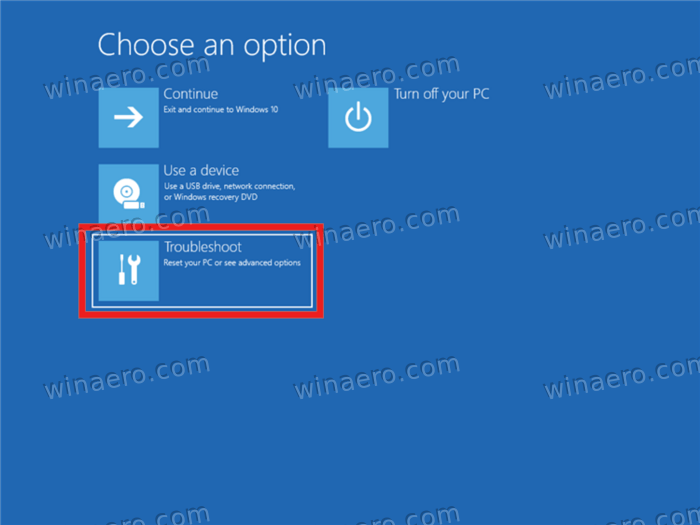
- On the next page, select Reset this PC.
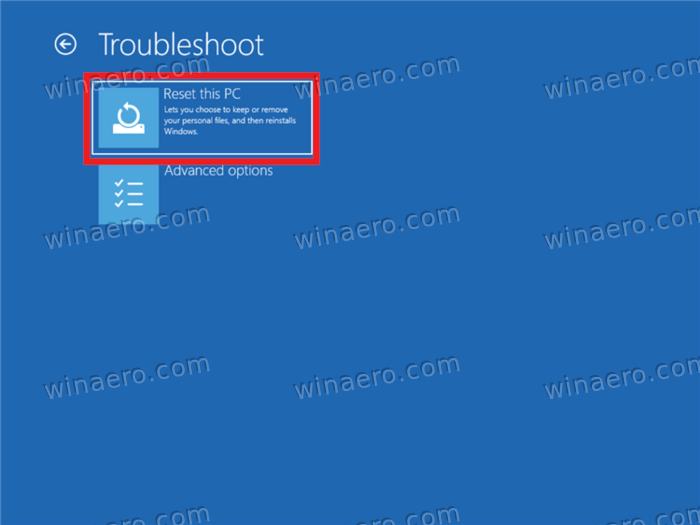
- On the screen that appears, select Keep my files if you want to save your data from being removed.
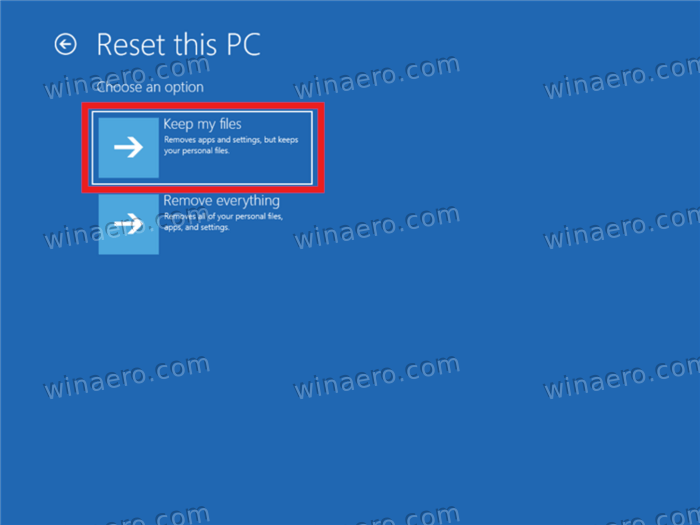
- Alternatively, you can select Remove everything.
Depending on how exactly you need to reset your computer, choose the appropriate method.
Option 1: Keep your files
- Select Local reinstall to use the recovery image that comes with your computer out of the box. Note that if your PC had Windows 10 preinstalled, and you later upgraded it to Windows 11, this will recover Windows 10 and not 11.
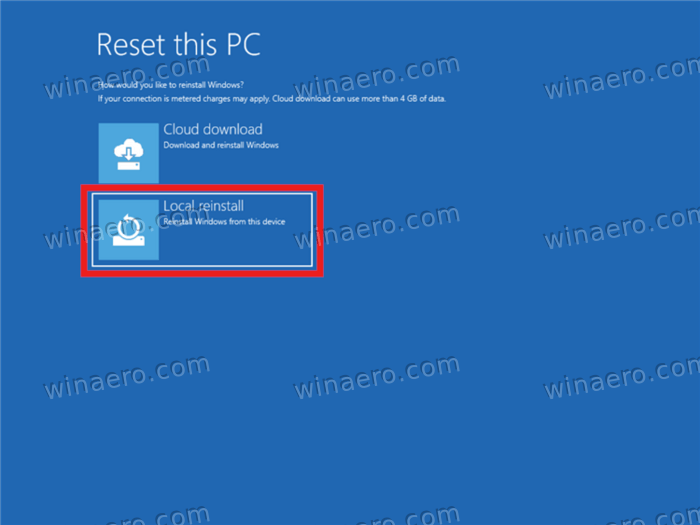
- If you have an Internet connection, you can go with the Cloud download option to reinstall Windows from the cloud instead. This method can be more dependable and, depending on your internet speed, may also be quicker. It is similar to reinstalling the OS from a USB stick but the files will be downloaded.
- Finally, click on the Reset button. Resetting Windows 11 will now start. This will take some time to finish. You will end up with a sign in screen where you need to select your user and provide credentials.
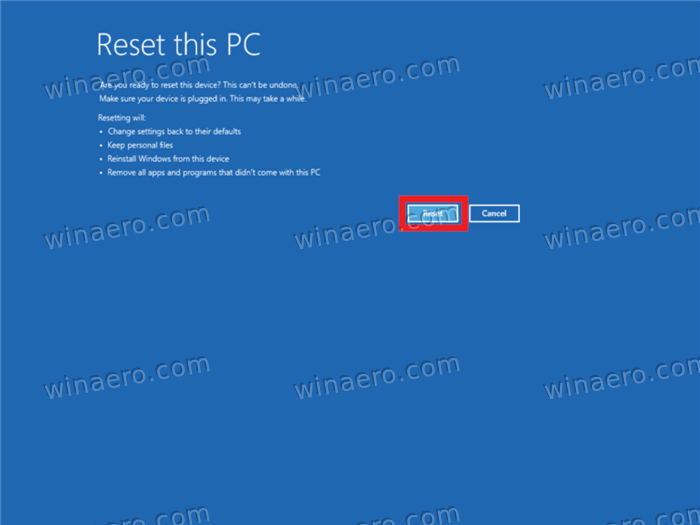
Note: After you sign in, you'll find a new file on the desktop called "Removed Apps.html". It contains the list of all apps removed by the reset process.
Option 2: Remove everything
- If To reset Windows 11 and remove everything, pick the appropriate item on the screen.
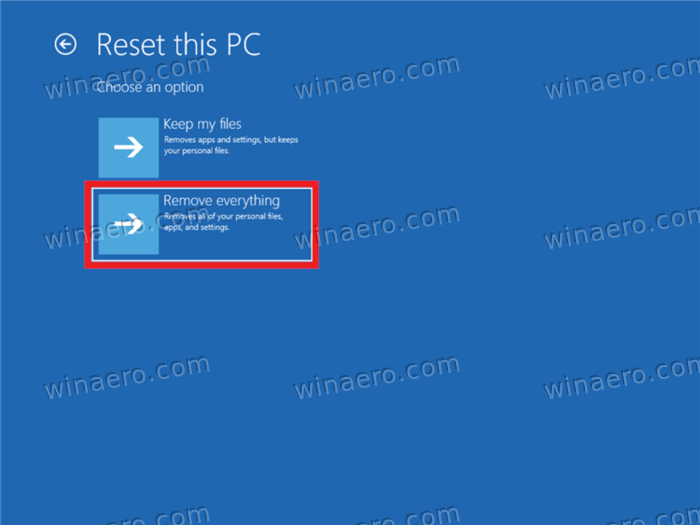
- Again, click either Cloud download or Local reinstall to specify the source of the installation files. The Local reinstall option is more reliable, but keep in mind the note above.
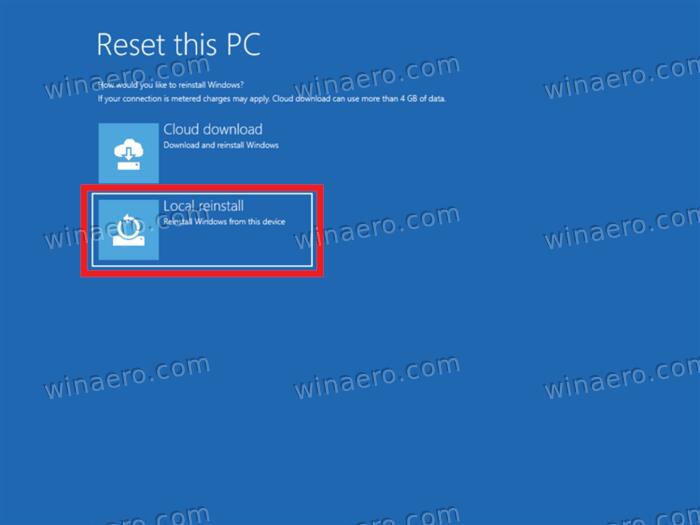
- If your PC has multiple drives on the Windows 11 disk, choose between erasing only the drive where Windows is installed or all drives. Selecting all drives will wipe out all partitions and volumes on the drive. Opting to erase only the drive where Windows is installed will only delete the partition or volume containing Windows 11.
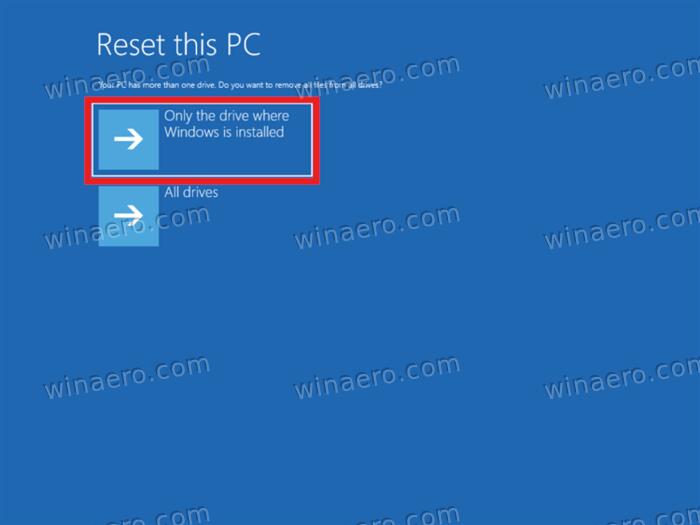
- Please select either Just remove my files or Fully clean the drive to determine how you want to do the removal.
- Choosing "Just remove my files" will quickly format the drive, but your files may still be recoverable. This option is ideal if you plan to keep your PC.
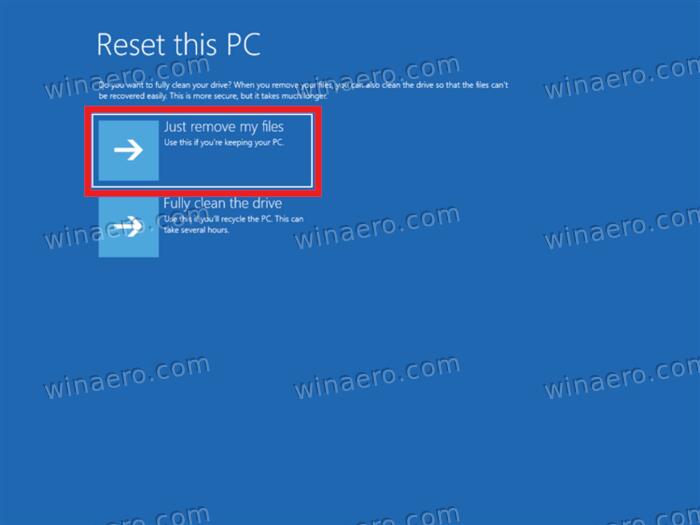
- Opting for "Fully clean the drive" will securely erase your files, making them very difficult to recover. This process may take several hours and is recommended if you are selling or recycling your computer.
- Choosing "Just remove my files" will quickly format the drive, but your files may still be recoverable. This option is ideal if you plan to keep your PC.
- Click on "Reset" to start resetting Windows 11. This may take some time to complete, and your PC will restart several times during the procedure. You will end up to OOBE (Out-of-box Experience).
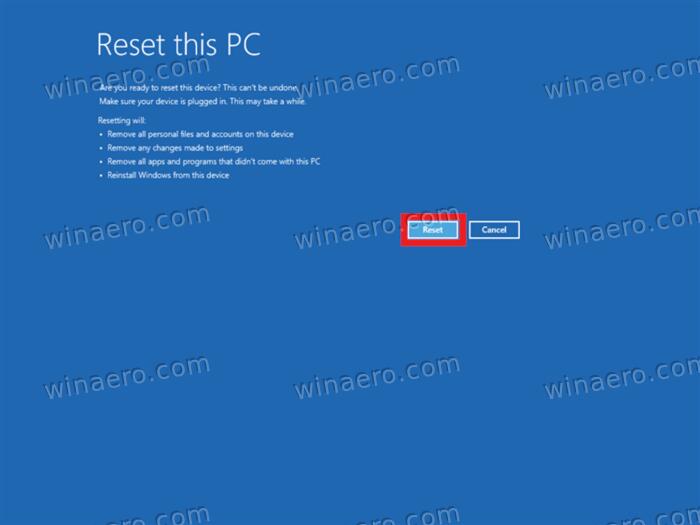
- If you are going to sell your device, do not change anything in the OOBE screens. Instead, press Shift + F10 and type
shutdown -s -t 0 -f. This will immediately turn off the computer and it is ready for selling.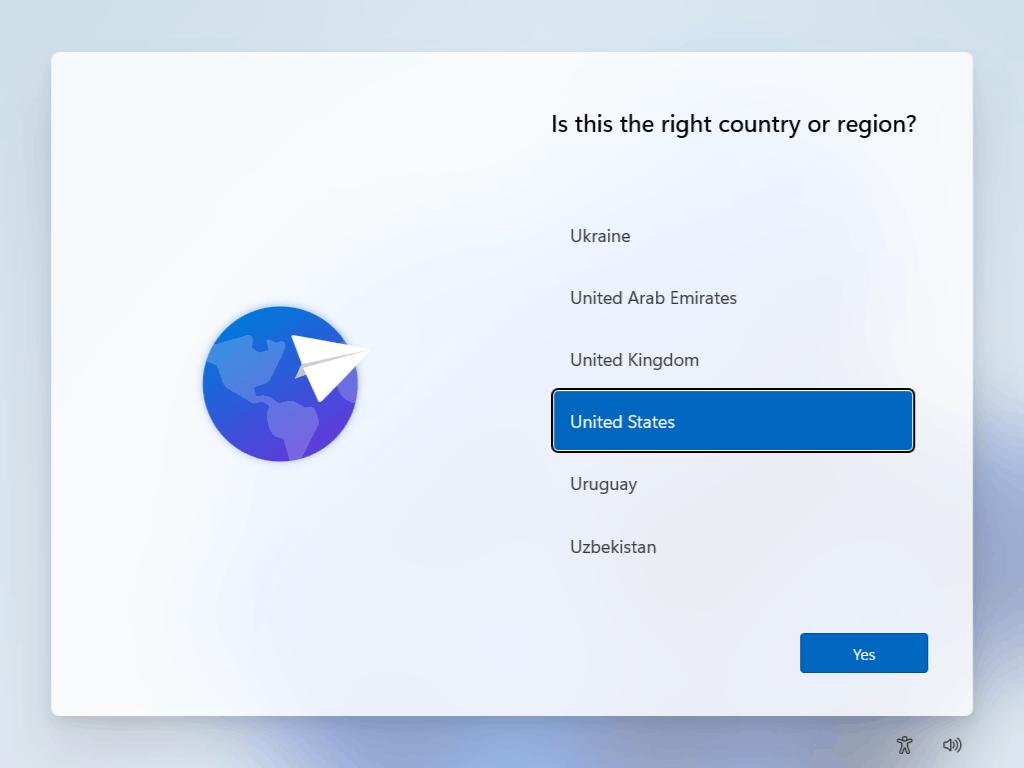
- Alternatively, specify your country, keyboard layout, and other regional options to finish the setup, just like in clean install.
Reset Windows 11 PC using the Settings app
- Press Win + I to open the Settings app.
- On the left, click System, then click Recovery on the right. You can directly open this section by using the
ms-settings:recoveryshell command.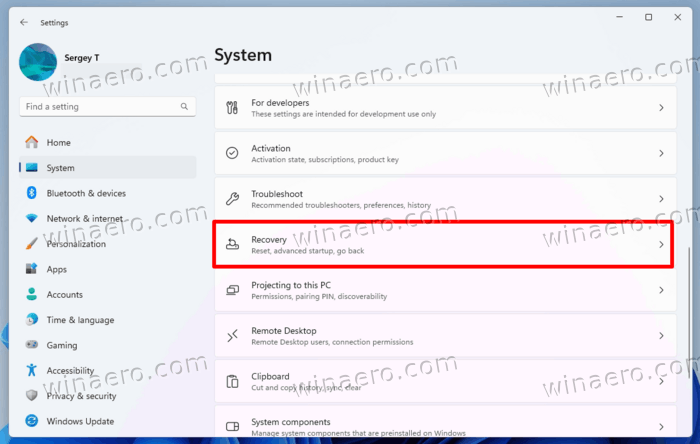
- Under Recovery options, click the Reset PC button located in the Reset this PC box on the right side.
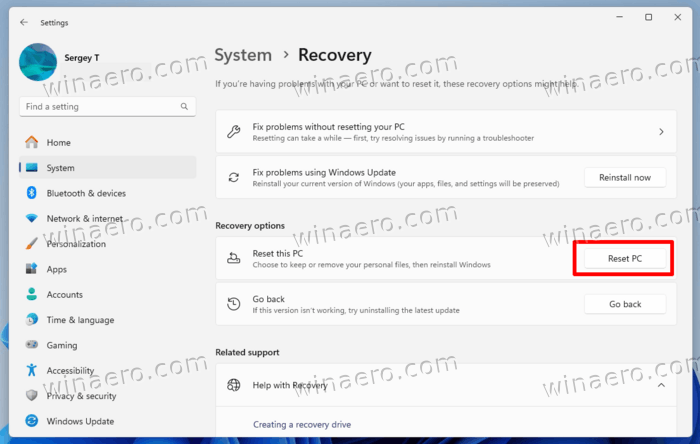
- The next dialog will greet you with two options, Keep your files and Remove everything. Choose the one that suits your needs.
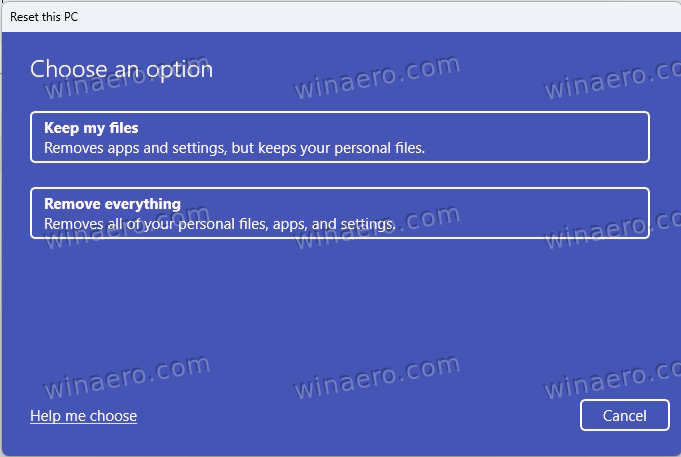
Keep your files when resetting the PC from Settings
- On the Reset dialog, click on the big Keep your files button.
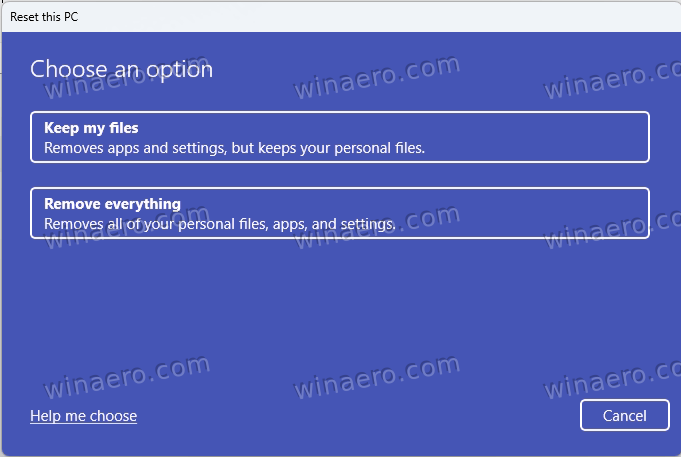
- Next, select Cloud download or Local reinstall. Cloud download will try to get the up-to-date files from the Internet, but the Local reinstall will use the Recovery data already stored on your PC and should work faster.
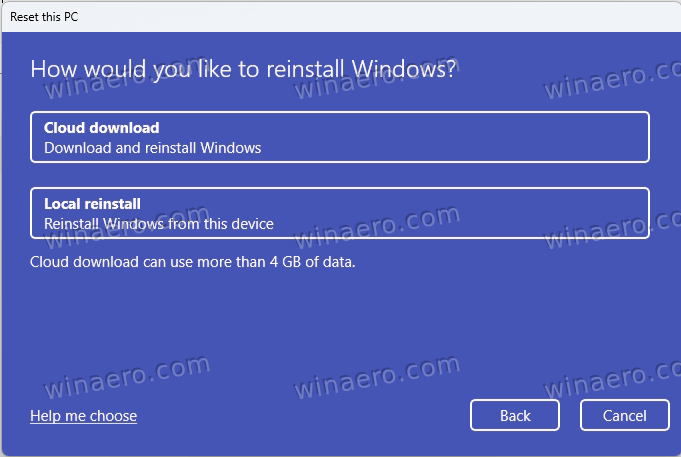
- On the next page, review the Current settings section and click the Change settings if something doesn't look correct.
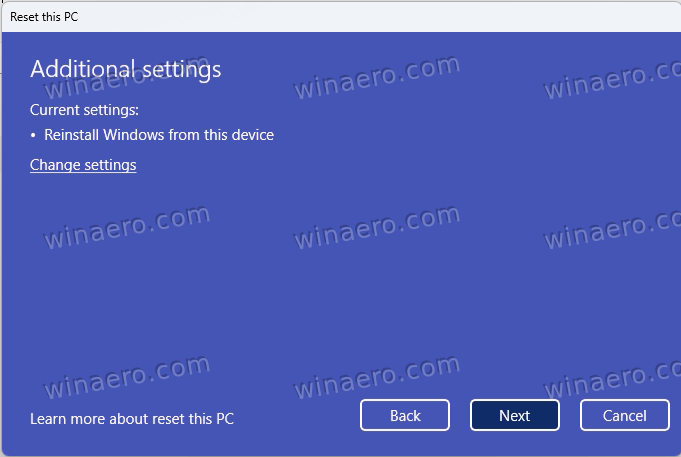
- In settings, enabling the Download option will make Windows 11 download actual files from the Internet even if you chose to use "Local reinstall".
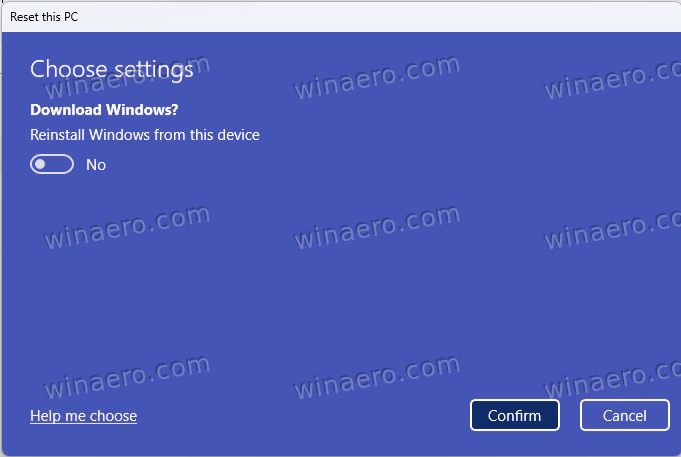
- If you see a notification about a Recent update, click Next in there to proceed.
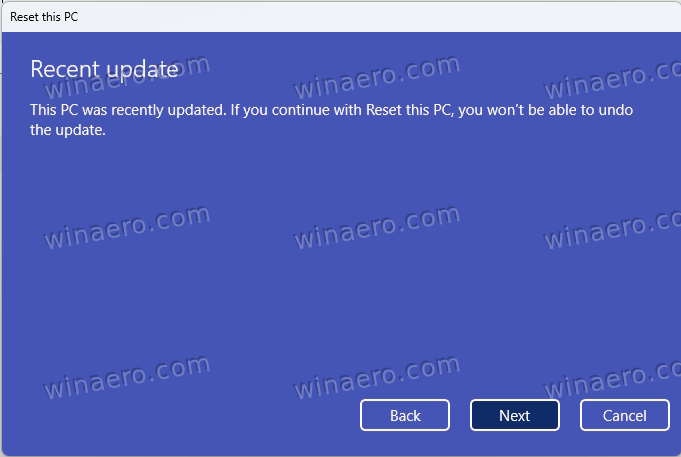
- Finally, on the next screen, click the View apps that will be removed link to see what apps will be uninstalled.
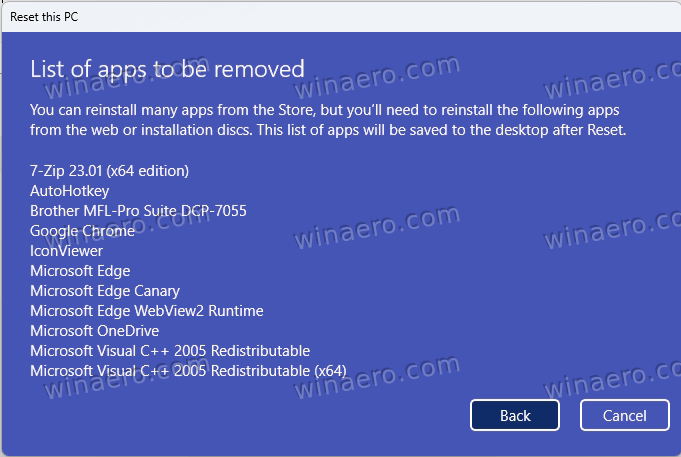
- Now click on the Reset button. Windows 11 will reset itself.
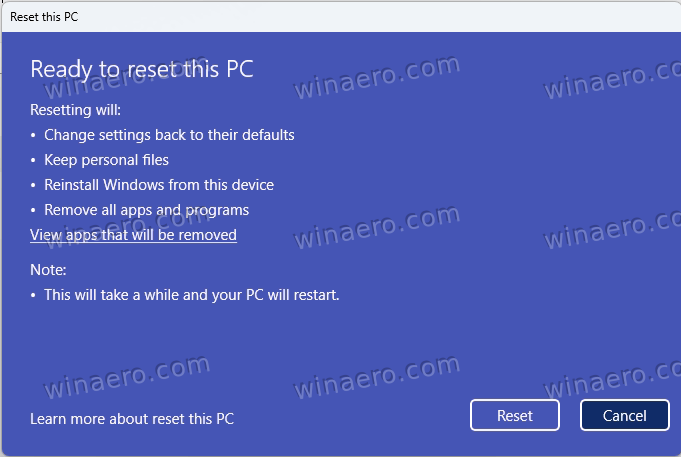
- Once you see the login screen, provide your user account credentials. A new file "Removed Apps.html" will be placed on the desktop. It contains the list of all apps removed by the reset process.

Once you sign in to Windows 11, you will start everything from scratch, despite having your files intact.
Remove everything with Reset from Settings
- In the Reset this PC dialog, click on the Remove everything item.
- Choose between Cloud download or Local reinstall. Cloud download attempts to retrieve the most recent files from the Internet, while Local reinstall utilizes the Recovery data already saved on your PC and is expected to operate more quickly.

-
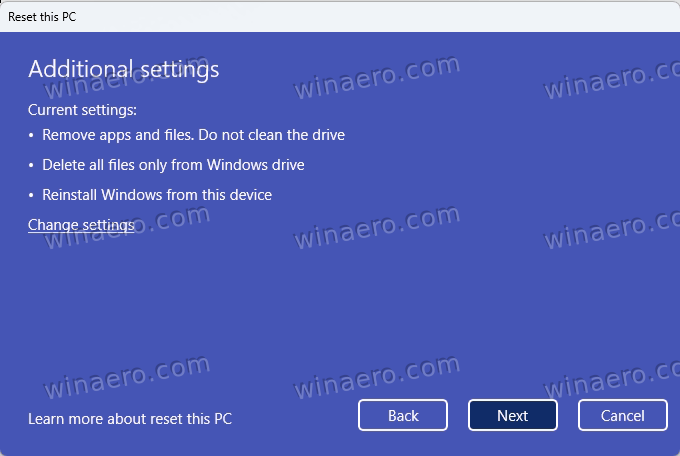 On the Additional settings step, carefully review the available options.
On the Additional settings step, carefully review the available options.- The option to Delete files from all drives will only appear if there are multiple drives/partitions on the Windows 11 disk. Selecting Yes here will erase all partitions/volumes on the Windows system disk. Selecting No will only erase the partition/volume where Windows is installed.
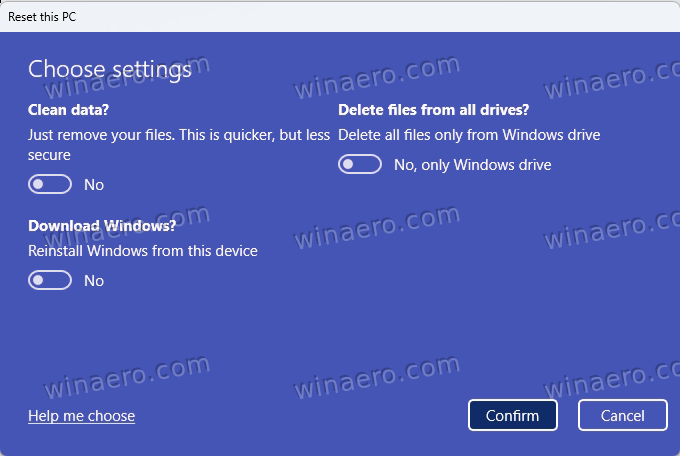
- Setting "Clean data? Just remove your files" to No will perform a quick format, marking your files as deleted and potentially recoverable. This option is suitable if you plan to keep your PC for yourself.
- Choosing Yes in "Clean data? Clean the drive" will securely erase your files by overwriting them, making them difficult to recover. This process may take several hours and is recommended if you are selling or recycling your computer.
- The Download Windows option in step is the same as Cloud download. It allows you to confirm or change this setting before beginning the reset process.
- The option to Delete files from all drives will only appear if there are multiple drives/partitions on the Windows 11 disk. Selecting Yes here will erase all partitions/volumes on the Windows system disk. Selecting No will only erase the partition/volume where Windows is installed.
- If you encounter a notification regarding a recent update, click on the "Next" button to continue.

- Finally, click on the Reset button and let Windows to reset itself.
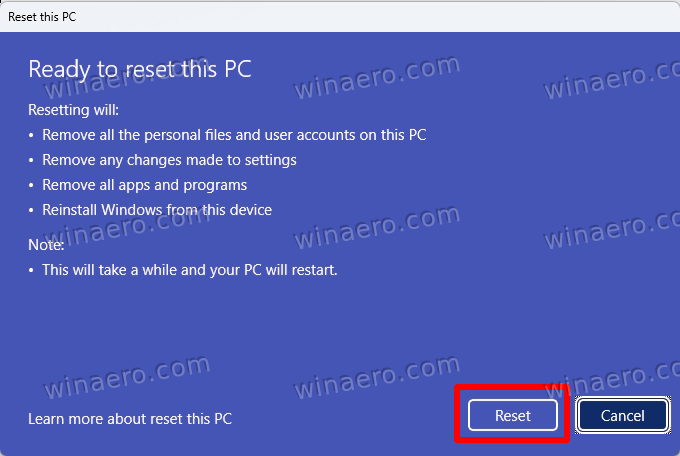
- You will end up to OOBE (Out-of-box Experience). If you are going to sell your device, do not change anything in the OOBE screens. Instead, press Shift + F10 and type
shutdown -s -t 0 -f. This will immediately turn off the computer, and now it is ready for selling. - Otherwise, specify your country, keyboard layout, and other regional options to finish the setup, just like in clean install.
One more method to reset Windows 11 is the inbox systemreset console tool. It is great for some automation, and is also convenient for
Reset Windows 11 Computer from Command Prompt
- Right-click the Start button in the taskbar, and select Terminal.
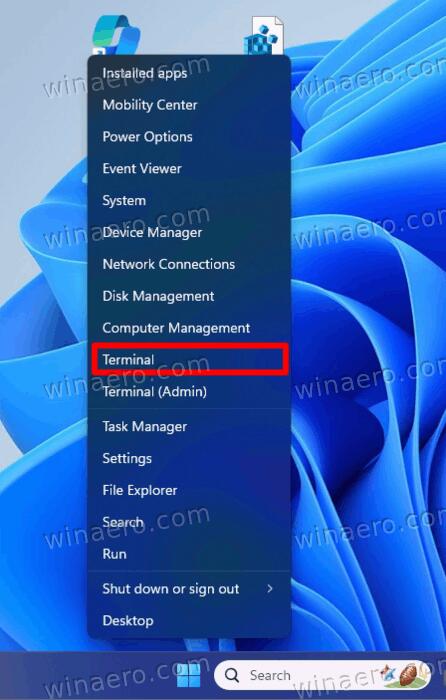
- In Terminal, select either Command Prompt (Ctrl + Shift +2) or PowerShell (Ctrl + Shift + 1, opens by default).
- Type or copy-paste the
systemreset --factoryresetcommand into the Terminal tab, and press Enter to run it.
- It will bring up the Windows Reset screen. At this step, select either Keep my files or Remove everything.

System reset with keeping your files
- In the reset screen, select Keep my files.
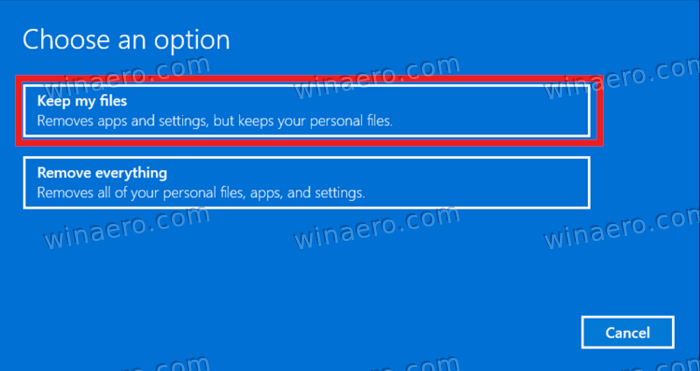
- Review the list of apps to be removed (if any), and click Next.
- Click on the Reset button when ready.
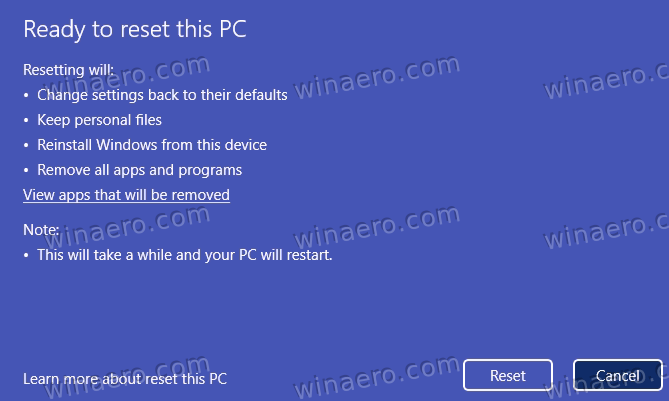
- After the reset finishes, you will end up with a sign in screen. A new file, Removed Apps.html, on the Desktop will contain the list of the removed software during reset.
You are done.
Removing everything and all
- In the reset screen, select Remove everything.
- On the next page, click Change settings and remove the options.
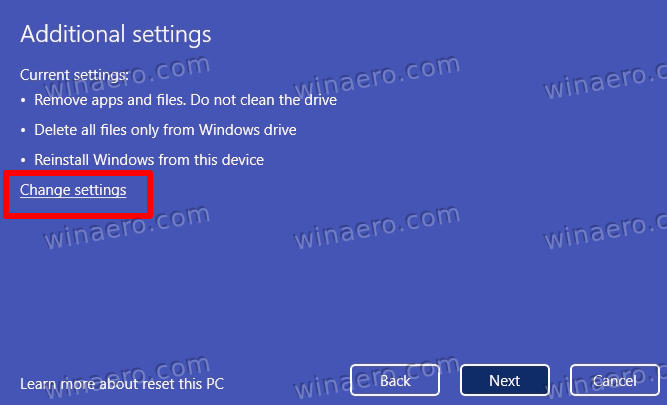
- Click or tap on either "Just remove my files" or "Fully clean the drive" to choose how you want to clean your drive.
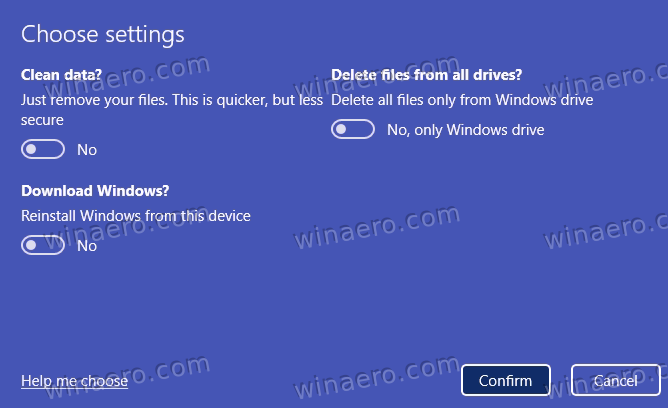
- Selecting "Just remove my files" will result in a quick format that does not take long. However, your files may still be recoverable since they are only marked as deleted. This option is suitable if you plan to continue using your PC.
- Alternatively, choosing "Fully clean the drive" will initiate a secure erase process that overwrites your files to prevent easy recovery. This method may take several hours to complete. It is recommended if you are planning to recycle or sell your computer.
- Finally, click on the Reset button to start the process.
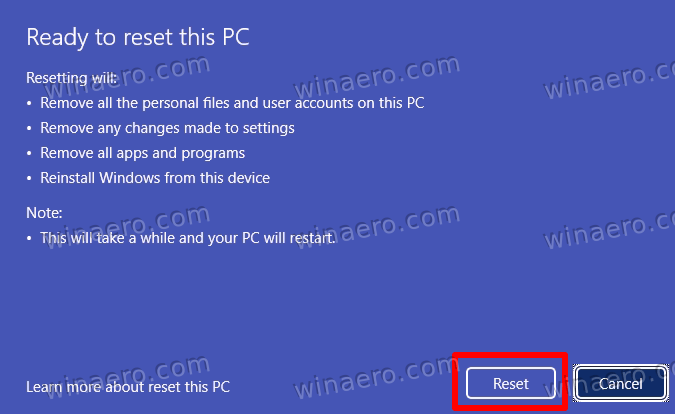
- After your device restarts several times, you will end up with the first time setup/OOBE screens. Specify your country, region keyboard like in regular setup.
That's it!
P.S. The official documentation of the Microsoft website includes some extra resources on the topic.
Support us
Winaero greatly relies on your support. You can help the site keep bringing you interesting and useful content and software by using these options:

A few years ago, I used the reset option. It was Windows 8, or Windows 10. Not Windows 11. The process would not complete, and I lost everything. I then had to take the PC to the local repair shop, to get the drive wiped and Windows reinstalled. In my opinion, this process is not without risk. –
Yeah. I still prefer to reinstall the OS manually with moving all my data to a separate folder and without formatting the drive.